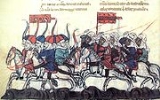
Second Battle of Homs
Encyclopedia
The Second Battle of Homs was fought in western Syria on October 29, 1281, between the armies of the Mamluk
dynasty of Egypt
and Ilkhanate
, division of the Mongol Empire
centered on Iran
. The battle was part of Abaqa Khan
's attempt at taking Syria
from the Mamluks.
After the Mamuluk victories over Mongols at Ain Jalut
in 1260 and Albistan in 1277, the Il-khan Abaqa sent his brother Möngke Temur at the head of a large army said to have numbered 80,000: 50,000 Mongols and 30,000 auxiliaries, chiefly Georgians
under King Demetrius II
and Armenians
under King Leo II.
The two armies met south of Homs
, a city in western Syria. In a pitched battle, the Georgians, Armenians and Oirats
under King Leo II and Mongol generals routed the Mamluk left flank and scattered Muslims, but the Mamluks personally led by Sultan
Qalawun
destroyed the Mongol centre. Möngke Temur was wounded and fled, followed by his disorganized army. However, Qalawun chose to not pursue the defeated enemy, and the Georgian-Armenian auxiliaries managed to withdraw.
The following year, Abaqa died and his successor, Tekuder
, reversed his policy. He converted to Islam
and forged an alliance with the Mamluk sultan.
Mamluk
A Mamluk was a soldier of slave origin, who were predominantly Cumans/Kipchaks The "mamluk phenomenon", as David Ayalon dubbed the creation of the specific warrior...
dynasty of Egypt
Egypt
Egypt , officially the Arab Republic of Egypt, Arabic: , is a country mainly in North Africa, with the Sinai Peninsula forming a land bridge in Southwest Asia. Egypt is thus a transcontinental country, and a major power in Africa, the Mediterranean Basin, the Middle East and the Muslim world...
and Ilkhanate
Ilkhanate
The Ilkhanate, also spelled Il-khanate , was a Mongol khanate established in Azerbaijan and Persia in the 13th century, considered a part of the Mongol Empire...
, division of the Mongol Empire
Mongol Empire
The Mongol Empire , initially named as Greater Mongol State was a great empire during the 13th and 14th centuries...
centered on Iran
Iran
Iran , officially the Islamic Republic of Iran , is a country in Southern and Western Asia. The name "Iran" has been in use natively since the Sassanian era and came into use internationally in 1935, before which the country was known to the Western world as Persia...
. The battle was part of Abaqa Khan
Abaqa Khan
Abaqa Khan , also Abaga , or Abagha Khan, was the second Mongol ruler of the Persian Ilkhanate. The son of Hulagu Khan and Yesuncin Khatun, he reigned from 1265–1282 and was succeeded by his brother Tekuder Khan...
's attempt at taking Syria
Syria
Syria , officially the Syrian Arab Republic , is a country in Western Asia, bordering Lebanon and the Mediterranean Sea to the West, Turkey to the north, Iraq to the east, Jordan to the south, and Israel to the southwest....
from the Mamluks.
After the Mamuluk victories over Mongols at Ain Jalut
Battle of Ain Jalut
The Battle of Ain Jalut took place on 3 September 1260 between Mamluks and the Mongols in eastern Galilee, in the Jezreel Valley, not far from Ein Harod....
in 1260 and Albistan in 1277, the Il-khan Abaqa sent his brother Möngke Temur at the head of a large army said to have numbered 80,000: 50,000 Mongols and 30,000 auxiliaries, chiefly Georgians
Georgia (country)
Georgia is a sovereign state in the Caucasus region of Eurasia. Located at the crossroads of Western Asia and Eastern Europe, it is bounded to the west by the Black Sea, to the north by Russia, to the southwest by Turkey, to the south by Armenia, and to the southeast by Azerbaijan. The capital of...
under King Demetrius II
Demetre II of Georgia
Saint King Demetrius II the Self-sacrificer , from the Bagrationi dynasty, was king of Georgia in 1270–1289.-Life:...
and Armenians
Armenian Kingdom of Cilicia
The Armenian Kingdom of Cilicia , also known as the Cilician Armenia, Kingdom of Cilician Armenia or New Armenia, was an independent principality formed during the High Middle Ages by Armenian refugees fleeing the Seljuk invasion of Armenia...
under King Leo II.
The two armies met south of Homs
Homs
Homs , previously known as Emesa , is a city in western Syria and the capital of the Homs Governorate. It is above sea level and is located north of Damascus...
, a city in western Syria. In a pitched battle, the Georgians, Armenians and Oirats
Oirats
Oirats are the westernmost group of the Mongols who unified several tribes origin whose ancestral home is in the Altai region of western Mongolia. Although the Oirats originated in the eastern parts of Central Asia, the most prominent group today is located in the Republic of Kalmykia, a federal...
under King Leo II and Mongol generals routed the Mamluk left flank and scattered Muslims, but the Mamluks personally led by Sultan
Sultan
Sultan is a title with several historical meanings. Originally, it was an Arabic language abstract noun meaning "strength", "authority", "rulership", and "dictatorship", derived from the masdar سلطة , meaning "authority" or "power". Later, it came to be used as the title of certain rulers who...
Qalawun
Qalawun
Saif ad-Dīn Qalawun aṣ-Ṣāliḥī was the seventh Mamluk sultan of Egypt...
destroyed the Mongol centre. Möngke Temur was wounded and fled, followed by his disorganized army. However, Qalawun chose to not pursue the defeated enemy, and the Georgian-Armenian auxiliaries managed to withdraw.
The following year, Abaqa died and his successor, Tekuder
Tekuder
Ahmed Tekuder , also known as Sultan Ahmad , was the sultan of the Persia-based Ilkhanate, son of Hulegu and brother of Abaqa. He was eventually succeeded by Arghun Khan...
, reversed his policy. He converted to Islam
Islam
Islam . The most common are and . : Arabic pronunciation varies regionally. The first vowel ranges from ~~. The second vowel ranges from ~~~...
and forged an alliance with the Mamluk sultan.

